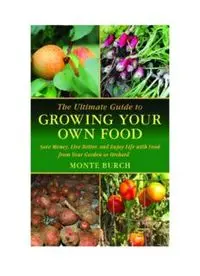
The Ultimate Guide to Growing Your Own Food: Save Money, Live Better, and Enjoy Life with Food from Your Garden or Orchard PDF
Preview The Ultimate Guide to Growing Your Own Food: Save Money, Live Better, and Enjoy Life with Food from Your Garden or Orchard
The Ultimate Guide to GROWING YOUR OWN FOOD The Ultimate Guide to GROWING YOUR OWN FOOD Save Money, Live Better, and Enjoy Life with Food from Your Own Garden Monte Burch Skyhorse Publishing Copyright © 2011 by Monte Burch All Rights Reserved. No part of this book may be reproduced in any manner without the express written consent of the publisher, except in the case of brief excerpts in critical reviews or articles. All inquiries should be addressed to Skyhorse Publishing, 307 West 36th Street, 11th Floor, New York, NY 10018. Skyhorse Publishing books may be purchased in bulk at special discounts for sales promotion, corporate gifts, fund-raising, or educational purposes. Special editions can also be created to specifications. For details, contact the Special Sales Department, Skyhorse Publishing, 307 West 36th Street, 11th Floor, New York, NY 10018 or Printed in China Contents Chapter 1 Why Grow Your Own Food Chapter 2 Planning to Grow Chapter 3 Preparing the Site Chapter 4 Growing Food in Small Spaces Chapter 5 Growing Vegetables Chapter 6 Vegetable Specifics Chapter 7 Growing Food for Fall and Winter Chapter 8 Growing Perennial Foods Chapter 9 Herbs Chapter 10 Small Fruits Chapter 11 The Home Orchard Index The Ultimate Guide to GROWING YOUR OWN FOOD 1 Why Grow Your Own Food Learning to grow food was a milestone in the development of the human race. As hunters and gatherers learned to cultivate food, they began to develop societies. Many of the Native Americans were expert food growers and taught the pilgrims to grow native foods such as corn, beans, and squash, thus sustaining the struggling settlements. A community food garden was the norm as these settlements grew. As the pioneers worked their way across the country, a food garden was a necessity for survival. In days past, every farm had a big garden, and even those in the cities with big backyards grew their own food. These days a much smaller number of people grow their own food, while most depend on the grocery-store shelves to provide their nutrition. These days, with all of our purchased food, we expect foods not in season to be available year-round. We also enjoy the experience of tasting new foods that have never been available in our local areas. is convenience comes at a high cost. Transporting food from east to west and from north to south from one end of the country to the other and from one country to another is a major use of oil for fuel. Packaging foods to be shipped also utilizes a tremendous amount of energy, as well as oil for producing plastic and trees for paper. Other major factors, however, are the taste and texture of food. Much of the produce found on today’s grocery-store shelves is bred to be picked green, not ripe, so it won’t ripen before it hits the stores. is produces, in some instances, a tasteless, hard-textured food. Just compare the hot-house tomato to a juicy freshly picked tomato from the garden. Growing your own food offers many benefits including a reduced use of our dwindling energy supplies as food is processed, packaged, and shipped all over the world. Tasting your own ripe tomatoes, fresh green beans, blueberries, and peaches, as well as apricots off your own trees, is far different from the produce you find at your local grocer’s. So why grow your own food? Granted, we can’t all have huge gardens completely fulfilling our food needs. But there are several good reasons to grow what we can. First is the taste. You simply can’t beat the taste of freshly picked sweet corn, brought in from the garden and directly to the table. The taste of homegrown tomatoes, ripe and bursting with juice, is heaven to a tomato lover. And how about fresh green beans with new potatoes, one of our families’ favorite homegrown dishes. Even those with limited space can grow their own salad garden, with fresh lettuce, spinach, onions, and radishes. Peaches and apples, luscious blueberries, blackberries, and strawberries that taste nothing like store-bought ones are also prime foods you can grow. The second reason is health. More and more problems are developing with commercially grown and processed foods. By growing your own, you can limit the use of harmful chemicals such as pesticides, insecticides, and herbicides. Or you may decide not to use any chemicals and grow organically. You will know what your family is eating when you grow it yourself. Doctors and researchers warn of our growing health problems from diabetes and obesity. Many people, especially youngsters, live on fast foods and don’t even get a minimum daily
